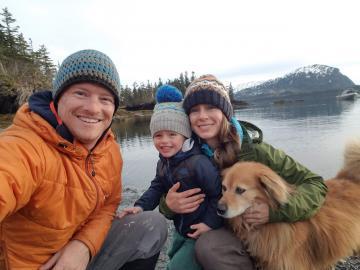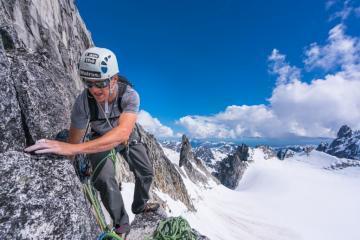
As a research ecologist at the Pacific Northwest Research Station, Sean Cahoon uses Forest Inventory and Analysis (FIA) data to understand long-term climate interactions with tree growth. His interest in the outdoors – and in public lands especially – was sparked by the extended time he spent growing up in Yosemite National Park. Today he lives and works in Alaska, where he collects tree ring data that can shed light on the relationship between climate and tree growth, and past ecological conditions.
Where did you grow up?
I grew up moving around a bit. I was born in Johannesburg, South Africa, then moved to Buffalo, New York. From there, we moved to Tampa, Denver, Cincinnati, Yosemite National Park, Cape Cod, and finally, I moved to Anchorage on my own after high school.
Who or what inspired you growing up?
My time as a kid growing up in Yosemite was pretty awe inspiring. It’s a unique playground, particularly when you’re 10 to 15 years old, and it really sparked my interest in the outdoors. Since then, I’ve learned the value of public lands and their stewardship through John Muir’s influence on the park and Henry David Thoreau’s writings from Cape Cod. I also credit a few excellent high school teachers that really encouraged and promoted my interest in the environment. Nelson Mandela’s life and activism is also a continuous motivation to be a better human being.
What do you like to do for fun on your free time?
My passion is skiing, but I love anything that gets me outside, whether its packrafting, biking, or climbing. These days, I find myself spending a lot time chasing my 3-year-old around the neighborhood and teaching him to ski and bike.
What do you do in the Forest Service and when did you start working here?
I started as an ORISE (Oak Ridge Institute for Science and Education) postdoc in February 2017 then was hired on permanently in October 2018. My position as a research ecologist primarily focuses on using Forest Inventory and Analysis (FIA) data to address pressing ecological questions about Alaska’s forests. FIA establishes and maintains a network of permanent sampling plots used to monitor America’s forests. I use tree cores collected from FIA plots to study long-term trends and drivers of tree growth throughout the state. The same forest inventory design is useful for exploring broad-scale patterns in ecosystem carbon pools. I focus on soil core data collected from FIA plots in interior Alaska to examine the distribution of soil carbon across various forest types, such as aspen, birch, black spruce, white spruce and stand ages.
How has your education, background, or personal experiences prepared you for the work that you do now?

I pursued a PhD in ecology, which really helped lay the groundwork for some of the basics of ecological theory, statistics, and hypothesis testing. I was lucky to have had some great mentors along the way that encouraged thinking outside the box and challenging oneself to pursue intellectual goals with passion. As a graduate student, I also accrued lots of experience conducting field work in remote places, so I can appreciate the hurdles our field crews face every day.
Describe a recent, current, or upcoming project that you're currently working on.
I’m really excited about the progress our interior Alaska FIA project has made since 2016. Along with partners from the U.S. National Park Service, Humboldt State University, and the University of Alaska Anchorage, we have focused on a region-wide analysis of white spruce tree-ring data from more than 200 FIA plots throughout interior Alaska. That type of resolution is unprecedented and should lead to new and exciting insights into the growth patterns of one of the most widespread species in the forests of the far north. I’ve also been busy analyzing the soil carbon data from interior Alaska, which is showing interesting patterns that will provide additional understanding of this large and important carbon pool from such a broad region.
Why do you think your field is important?
Forest ecosystems are a vital part of global cycles of water, nutrients, and energy. Developing a better understanding of the benefits provided by forests is an important component of maintaining clean water and air, providing healthy habitat for fish and wildlife, and reducing atmospheric carbon dioxide. These elements benefit society at local and global scales. My small part of forest ecology seeks to understand how these connected natural networks respond to various stresses to help predict what services may be jeopardized by current and future trends.

What are some of the greatest challenges confronting your field?
From a scientific perspective, understanding the complex interactions between forests and changes in climate is a major challenge for ecologists attempting to quantify forest productivity and the exchange of energy, water and carbon between the earth and the atmosphere. Also, current events have really sharpened the focus on the lack of diversity among scientists, which can limit scientific insight and perspective. Another challenging aspect is the communication between researchers and the general public. It’s an admirable skill to boil years of complex research down to a 30-second “elevator pitch”.
What are some of the most promising strategies being used by the Forest Service to address these challenges?
The Forest Service’s commitment to implementing FIA in interior Alaska—where climate change is most dramatic—will vastly improve national and global ability to estimate above- and below-ground carbon stocks that may be highly sensitive to changes in climate or wildfire. Additionally, PNW’s carbon research initiative has yielded some exciting findings and many valuable collaborations.


